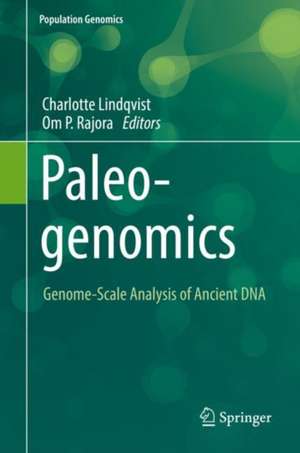Paleogenomics: Genome-Scale Analysis of Ancient DNA: Population Genomics
Editat de Charlotte Lindqvist, Om P. Rajoraen Limba Engleză Hardback – 24 ian 2019
Advances in genome-scale DNA sequencing technologies have revolutionized genetic research on ancient organisms, extinct species, and past environments. When it is recoverable after hundreds or thousands of years of unintended preservation, “ancient DNA” (or aDNA) is often highly degraded, necessitating specialized handling and analytical approaches. Paleogenomics defines the field of reconstructing and analyzing the genomes of historic or long-dead organisms, most often through comparison with modern representatives of the same or similar species. The opportunity to isolate and study paleogenomes has radically transformed many fields, spanning biology, anthropology, agriculture, and medicine. Examples include understanding evolutionary relationships of extinct species known only from fossils, the domestication of plants and animals, and the evolution and geographical spread of certain pathogens. This pioneering book presents a snapshot view of the history, current status, and future prospects of paleogenomics, taking a broad viewpoint that covers a range of topics and organisms to provide an up-to-date status of the applications, challenges, and promise of the field. This book is intended for a variety of readerships, including upper-level undergraduate and graduate students, professionals and experts in the field, as well as anyone excited by the extraordinary insights that paleogenomics offers.
Preț: 1229.10 lei
Preț vechi: 1498.90 lei
-18% Nou
Puncte Express: 1844
Preț estimativ în valută:
235.26€ • 255.63$ • 197.75£
235.26€ • 255.63$ • 197.75£
Carte disponibilă
Livrare economică 31 martie-14 aprilie
Preluare comenzi: 021 569.72.76
Specificații
ISBN-13: 9783030047528
ISBN-10: 3030047520
Pagini: 427
Ilustrații: XIV, 427 p. 62 illus., 57 illus. in color.
Dimensiuni: 155 x 235 x 28 mm
Greutate: 0.77 kg
Ediția:2019
Editura: Springer International Publishing
Colecția Springer
Seria Population Genomics
Locul publicării:Cham, Switzerland
ISBN-10: 3030047520
Pagini: 427
Ilustrații: XIV, 427 p. 62 illus., 57 illus. in color.
Dimensiuni: 155 x 235 x 28 mm
Greutate: 0.77 kg
Ediția:2019
Editura: Springer International Publishing
Colecția Springer
Seria Population Genomics
Locul publicării:Cham, Switzerland
Cuprins
Part1. Concepts, Technical Advances and Challenges.- Chapter1. Technical Advances and Challenges in Genome-Scale Analysis of Ancient DNA.- Chapter2. Paleoproteomics: An Introduction to the Analysis of Ancient Proteins by Soft Ionization Mass Spectrometry.- Chapter3. Ancient RNA.- Chapter4. Ancient Epigenomics.- Part2. .- Chapter5. Ancient Pathogens Through Human History: A Paleogenomic Perspective.- Chapter6. Paleovirology: Viral Sequences from Historical and Ancient DNA.- Chapter7. Reconstructing Past Vegetation Communities Using Ancient DNA from Lake Sediments.- Chapter8. Archaeogenomics and Crop Adaptation.- Chapter9. Herbarium Genomics: Plant Archival DNA Explored.- Chapter10. Paleogenomics of Animal Domestication.- Chapter11. Paleogenomic Inferences of Dog Domestication.- Chapter12. Of Cats and Men: Ancient DNA Reveals How the Cat Conquered the Ancient World.- Chapter13. An Ancient DNA Perspective on Horse Evolution.- Chapter14. Primate Paleogenomics.- Chapter15. Structural Variants in Ancient Genomes.- Chapter16. Genomics of Extinction.
Recenzii
“This book is intended for a variety of readers, including upper-level undergraduate and graduate students, professionals, and experts in the field, as well as anyone excited by the extraordinary insights that paleogenomics offers. This well-written volume is for well-read undergraduate students, and is definitely a good read for graduate students and professionals.” (Lorin R. King, The Quarterly Review of Biology, Vol. 95 (4), December, 2020)
Notă biografică
Dr. Charlotte Lindqvist
Associate Professor
University at Buffalo (SUNY)
Department of Biological Sciences
Buffalo, NY
USA
Dr. Om P. Rajora
Professor
University of New Brunswick
Fredericton, NB E3C 5A3
Canada
Textul de pe ultima copertă
Advances in genome-scale DNA sequencing technologies have revolutionized genetic research on ancient organisms, extinct species, and past environments. When it is recoverable after hundreds or thousands of years of unintended preservation, “ancient DNA” (or aDNA) is often highly degraded, necessitating specialized handling and analytical approaches. Paleogenomics defines the field of reconstructing and analyzing the genomes of historic or long-dead organisms, most often through comparison with modern representatives of the same or similar species. The opportunity to isolate and study paleogenomes has radically transformed many fields, spanning biology, anthropology, agriculture, and medicine. Examples include understanding evolutionary relationships of extinct species known only from fossils, the domestication of plants and animals, and the evolution and geographical spread of certain pathogens. This pioneering book presents a snapshot view of the history, current status, and future prospects of paleogenomics, taking a broad viewpoint that covers a range of topics and organisms to provide an up-to-date status of the applications, challenges, and promise of the field. This book is intended for a variety of readerships, including upper-level undergraduate and graduate students, professionals and experts in the field, as well as anyone excited by the extraordinary insights that paleogenomics offers.
.
Caracteristici
Paleogenomics is the first comprehensive book on paleogenomics, a rapidly evolving and fascinating field that investigates the genomes of ancient organisms and extinct species Chapters in this book are contributed by some of the leaders in the field, covering a wide array of topics This book provides insight into recent developments of concepts, technical advances and challenges, and promise of paleogenomics This book reviews and synthesizes studies applying paleogenomics to a variety of organisms, from pathogens and plants to primates This book analyzes current insights from paleogenomics into past environments, the evolution and adaptation of organisms to changing environmental conditions over a long period of time, and the processes of domestication and extinction





